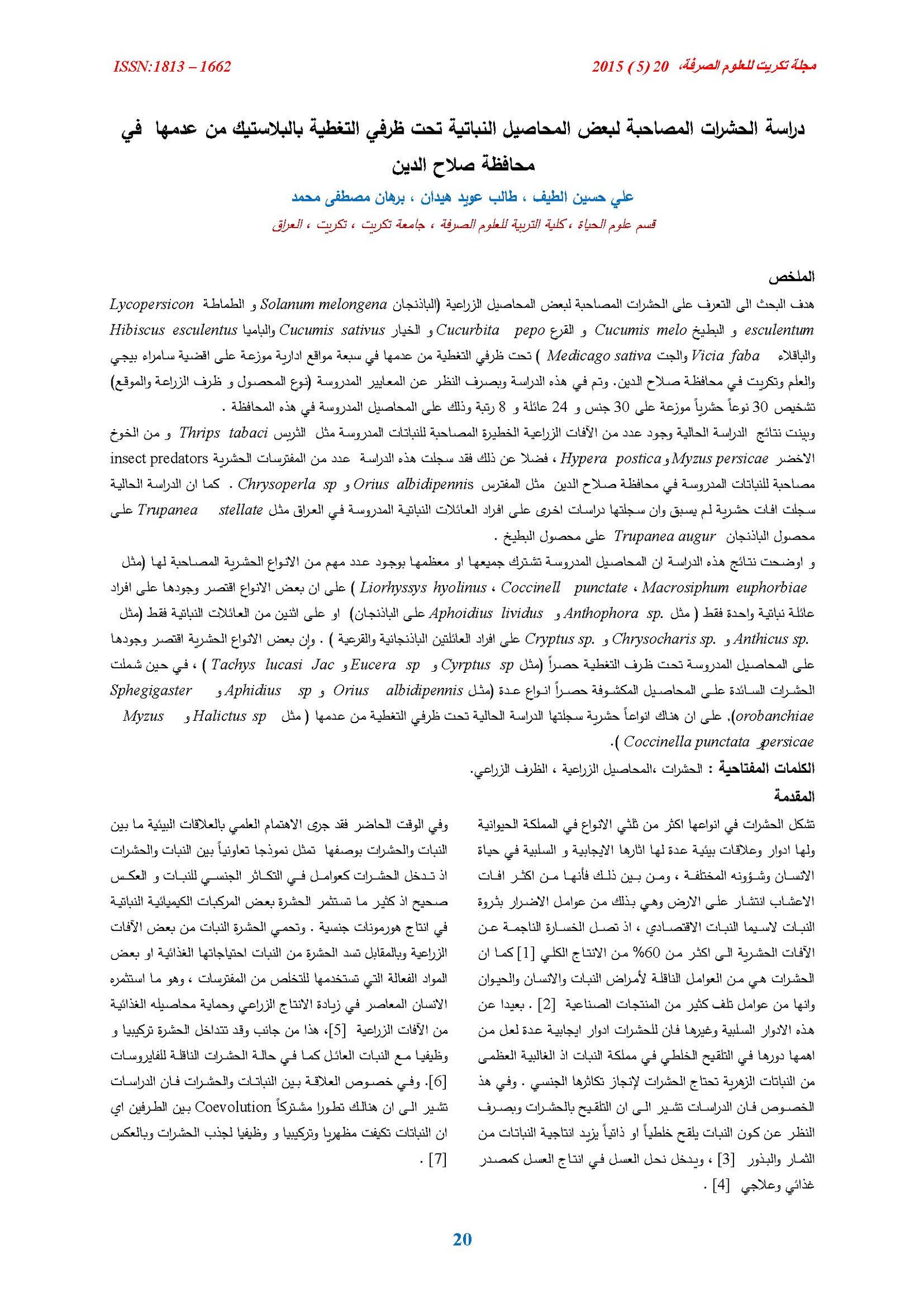Insects associated with crop plants in and out plastic tunles in Salahaldin Governorate
Main Article Content
Abstract
The present study was carried out during December 2011-july 2012 in several areas in salah-aldin governorate to provide information on insect fauna associated with some economic field crops under plastic cover and crops after cover removal .The study also aimed to obtain information about the chemistry of plant –insect relationship .
A total of 30 insect species from 24 families and 8 orders were collected from the studied crops . more than 30 unidentified insect species in different families and order were also collected from these crops. among collected insects , several insect pests ( ex. Thrips tabaci, Chrysoperla sp, Myzus persicae, Halictus sp, Hypera postica) insect predates ( ex. Orius albidipennis , Sphegigaster orobanchiae) insect pollinators (ex. Anthophora sp, Halictus sp, Andrena sp) and parasitic insects (ex. Aphidius sp ) were reported .
It was revealed that some insect species occurred on all studied crops (ex. Myzus persicae, Coccinella punctate and Liorhyssys hyolinus) while other insect species were restricted to members of one ( ex. Aphoidius lividus, and Anthophora sp. on eggplant) or two plant families ( ex. Anthicus sp, Chrysocharis sp. And Cryptus sp on cuecrbitaceae and solanceae ) . some insect species were found only on covered plants ( ex. Cryptus sp, Eucera sp. And Tachys lucasi) whereas others were found dominant only on uncovered plants (ex. Orius albidipennis, Aphidius sp and Sphegigaster orobanchiae). However , several insect species were found on both covered and uncovered crops ( ex. Halictus sp, Myzus persicae and Coccinella punctate).
Article Details

This work is licensed under a Creative Commons Attribution 4.0 International License.
Tikrit Journal of Pure Science is licensed under the Creative Commons Attribution 4.0 International License, which allows users to copy, create extracts, abstracts, and new works from the article, alter and revise the article, and make commercial use of the article (including reuse and/or resale of the article by commercial entities), provided the user gives appropriate credit (with a link to the formal publication through the relevant DOI), provides a link to the license, indicates if changes were made, and the licensor is not represented as endorsing the use made of the work. The authors hold the copyright for their published work on the Tikrit J. Pure Sci. website, while Tikrit J. Pure Sci. is responsible for appreciate citation of their work, which is released under CC-BY-4.0, enabling the unrestricted use, distribution, and reproduction of an article in any medium, provided that the original work is properly cited.
References
1- Trematerra, P.; Luciano, P. and Paparatti, B. (2000). Monitoring of Phthorimaea operculella using pheromone traps. Informatore Fitopatologico. 46: 10, 55-59.
2- Froissart, R.; Michalakis, Y.; Blanc, S.(2002). Helper component transcomplementation in the vector transmission of plant viruses. Phytopathology , 92 (6), 576–579.
3- Ortiz-Perez, E.; Horner, H.T.; Hanlin, S.J. and Palmer, R.G. (2006). Evaluation of insect-mediated seed set among soybean lines segregating for male sterility at the ms6 locus. Field Crops Res 97:353–362.
4- Biesmeijer, J.C.; Roberts, S.P.M.; Reemer, M.; Ohlemueller, R.; Edwards, M.; Peeters, T.; Schaffers, A.P.; Potts, S.G.; Kleukers, R.; Thomas, C.D.; Settele, J.and Kunin, W.E. (2006). Parallel declines in pollinators and insect-pollinated plants in Britain and the Netherlands, Science 313, 351–354.
5- Qaim, M. and Janvry, A.D. (2005). Bt cotton and pesticide use in Argentina: Economic and environmental effects. Environ. Dev. Econ. 10: 199-200.
6- Hogenhout, S. A.; Ammar, E. D.; Whitfield, A. E.; and Redinbaugh, M. G. (2008). Insect vector interactions with persistently transmitted viruses. Annu. Rev. Phytopathol. 46:327-359.
7- Andow, D. A. (1990). Population dynamics of an insect herbivore in simple and diverse habitats. Ecology 71: 1006–1017.
8-Hutchison, W.D. (1993). Alfalfa IPM: sampling alfalfa insects. University of Minnesota Extension Service, Pub. FO-3516-GO.
9- McGovern, T. H.; Sophia Perdikaris, A. E. and Jane, S. (2007). Coastal connections, local fishing, and sustainable egg harvesting: patterns of Viking Age inland wild resource use in Myvatn district, Northern Iceland. Environmental Archaeology 11(2):187-205.
10- Bowden, J. (1982). An analysis of factors affecting catches of insects in light-traps. – Bull. ent. Res. 72: 535-556.
12- Dry, I.B.; Rigden, J..E.; Krake, L.R.; Mullineaux, P.M. and Rezaian, M.A. (1993). Nucleotide sequence and genome organization of tomato leaf curl geminivirus. J Gen Virol 74: 147–151.
13_ Mehta, P.; Wyman, J.A.; Nakhla, M.K. and Maxwell, D.P. (1994). Transmission of tomato yellow leaf curl geminivirus by Bemisia tabaci Homoptera: Aleyrodidae). J Econ Entomol 87: 1 291–1 297.
14_ Hardy, D.E. and Delfinado, M.D.(1969). The Bibionidae (Diptera) of the Philippines. Pacific Insects 11(1): 117–154.
16-Irwin, J. T. and Lee, R. E. (2002). Energy and water conservation in frozen vs. supercooled larvae of the goldenrod gall fly, Eurosta solidaginis (Fitch) (Diptera: Tephritidae). – J.Exp. Zool. 292: 345–350 .
17- Disney, R. H. L. (2001) Sciadoceridae (Diptera) reconsidered. Fragmenta Faunistica 44: 309-317.
18-Suasa-ard, W.; Suksen K. and Kern-asa, O. (2011). Utilization of the green muscardine, Metarhizium anisopliae, to control the sugarcane longhorn stem borer Dorysthenes buqueti Guerin (Coleoptera: Cerambycidae). Paper presented at the XXVII ISSCT Sugarcane Entomology Congress. Veracruz, Maxico. March 7-11.
19-Cikman, E. and M. Doganlar, M.(2006). Parasitoids of natural populations of Phytomyza orobanchia (Kaltenbach,1864) (Diptera: Agromyzidae) in Southeastern Anatolia. Journal of Applied Science Research 2(6): 327-330.
21-Suasa-ard, W.; Maneerat, T.; Wonnarat,P. and Kernasa, O. (2010). Technological development of green lacewings, Cotesia flavipes (Cameron) (Hymenoptera: Braconidae) for commercial production. Annual Reports of National Biological Control Research Center . Petchaburi, Thailand. September 1-3, .
22-Shebl, M.A.; Kamel, S.M.; Abu Hashesh, T.A. and Osman, M.A.(2008). The impact of leafcutting bees (Megachile minutissima, Megachilidae, Hymenoptera) (Radoszkowski, 1876) artificial nest sites on seed production of alfalfa Ismailia, Egypt. J.Agricultura. 5: 33-35.
23-Singer, T.; Kiebel, S. J.; Winston, J. S.; Dolan, R. J. and Frith, C. D.(2004) “Brain Responses to the Acquired Moral Status of Faces.” Neuron, 41(4), pp. 653–62.
24- Pereyra, P.C. and Sanchez, N.E. (2006). Effects of two Solanaceous plants on developmental and population parameters of the Tomato leaf miner, Tuta absoluta (Meyrick) (Lepidoptera: Gelechiidae). Neotropical Entomol 35 (5): 671-676.
